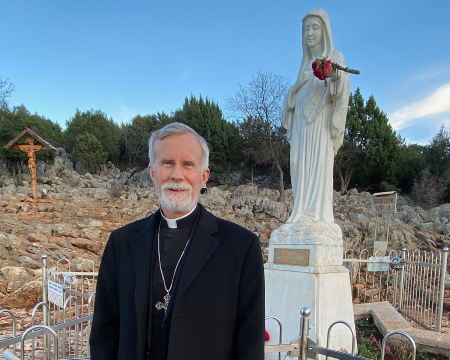We ask you, humbly: don't scroll away.
Hi readers, it seems you use Catholic Online a lot; that's great! It's a little awkward to ask, but we need your help. If you have already donated, we sincerely thank you. We're not salespeople, but we depend on donations averaging $14.76 and fewer than 1% of readers give. If you donate just $5.00, the price of your coffee, Catholic Online School could keep thriving. Thank you.Help Now >
St. Eimhin
FREE Catholic Classes
Abbot and Bishop of Ros-mic-Truin ( Ireland ), probably in the sixth century. He came of the royal race of Munster, and was brother of two other saints, Culain and Dairmid. Of the early part of his religious life little is known. When he became abbot of the monastery of Ros-mic-Truin, in succession to its founder, St. Abban, he had been apparently connected with one of the religious houses of the south of Ireland, since it is recorded that a number of monks "followed the man of God from his own country of Munster". Ros-mic-Truin lies in South Leinster on the bank of the River Barrow, and is distant only eight miles, by water, from the confines of Munster, at the point where the Suir and Barrow meet, and in confluence enter the Atlantic. Although the Abbey of Ros-mic-Truin was founded by St. Abban, it is said to have been colonized by St. Eimhin, and from the number of religious and students belonging to the south of Ireland who dwelt there the place came to be called "Ros-glas of the Munstermen". St. Eimhin is said by some to have been the author of the life of St. Patrick, called the "Vita Tripartita" (ed. Whitley Stokes in R.S.), originally published by Father John Colgan, O.S.F. It contains a greater variety of details concerning the mission of the Apostle of Ireland than any other of the lives extant. St. Eimhin was famous for many and great miracles. The date of his death has not been recorded; however competent authorities assign it to the earlier half of the sixth century. After St. Eimhin's death, it is said, his consecrated bell was held in great veneration, and was used as a swearing relic down to the fourteenth century, oaths and promises made upon it being deemed inviolable. Among the manuscripts of the library of the Royal Irish Academy, Dublin, is a prose tract entitled "Caine Emine" (i.e. the tribute or rule of Eimhin), also a poem of several stanzas relating to the saint's bell. St. Eimhin is given in the Irish calendars on 22 December.









 Daily Readings for Saturday, April 20, 2024
Daily Readings for Saturday, April 20, 2024 St. Marian: Saint of the Day for Saturday, April 20, 2024
St. Marian: Saint of the Day for Saturday, April 20, 2024 Children's Prayer For Parents: Prayer of the Day for Saturday, April 20, 2024
Children's Prayer For Parents: Prayer of the Day for Saturday, April 20, 2024

